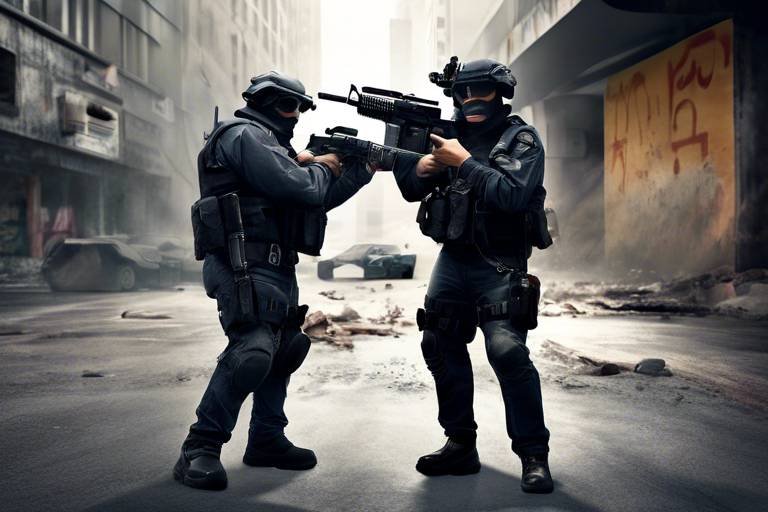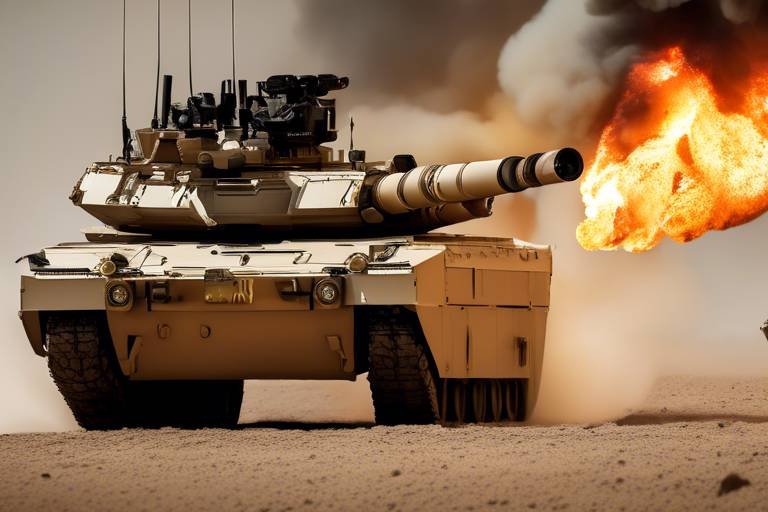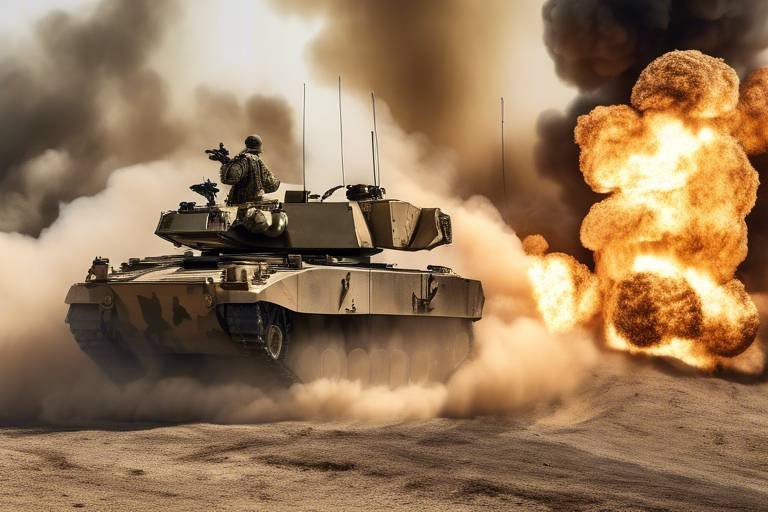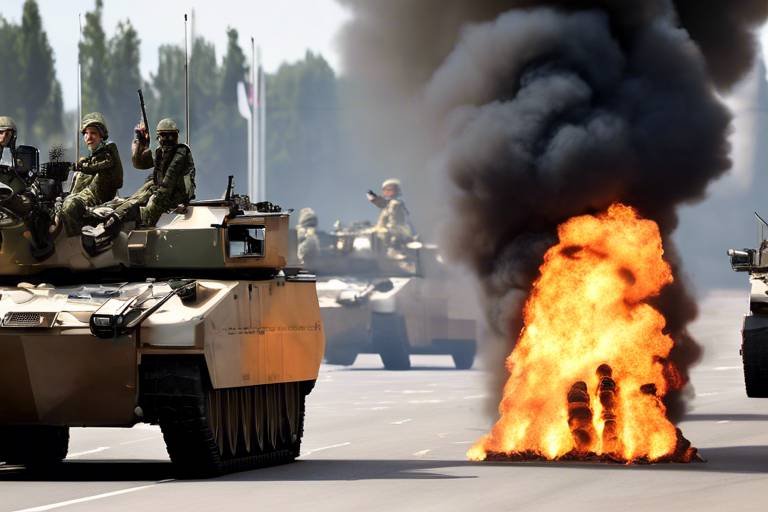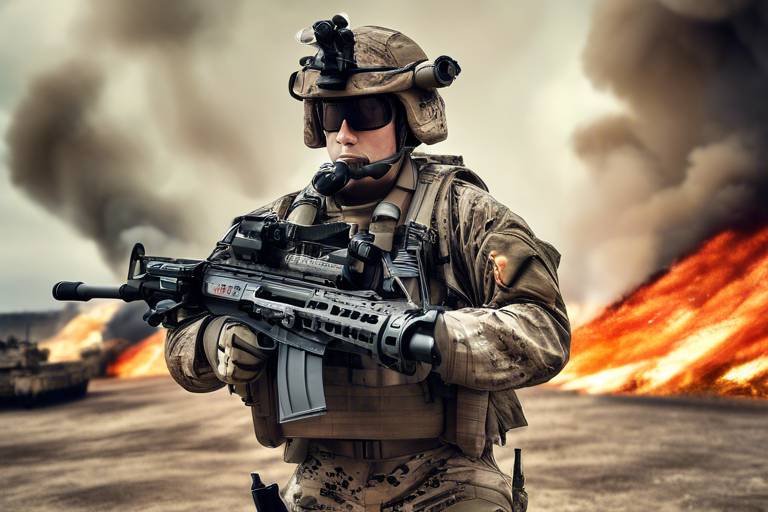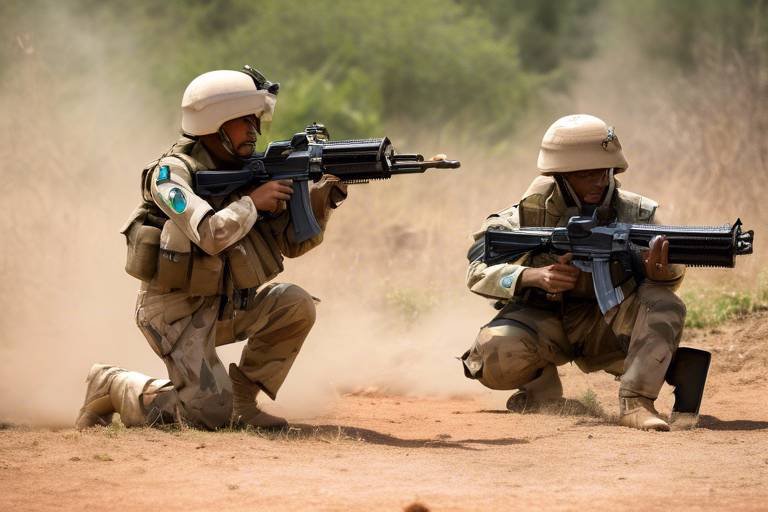The Use of Enhanced Weapons in Urban Environments
This article explores the implications, strategies, and technologies associated with enhanced weaponry in urban settings, focusing on both military and law enforcement applications, as well as the ethical considerations involved.
Urban warfare has transformed significantly over the years, influenced by advancements in technology and changes in combat strategy. In the past, cities were often seen as battlegrounds where the chaos of war could be contained. However, as technology has evolved, so too has the nature of warfare in urban environments. Today, we see a blend of traditional tactics and cutting-edge technology, creating a complex battlefield where every street corner can become a strategic point. The shift from conventional warfare to asymmetric tactics has necessitated new approaches, and enhanced weapons have become a crucial part of this evolution.
Enhanced weapons encompass a range of technologies, including drones, smart munitions, and non-lethal options. Each type of enhanced weapon is designed for specific applications in urban environments, addressing the unique challenges posed by densely populated areas. For instance, drones can provide real-time surveillance, while smart munitions can be programmed to hit precise targets with minimal collateral damage. Non-lethal weapons, on the other hand, are increasingly utilized in urban policing to manage crowds and minimize fatalities. These tools not only enhance operational effectiveness but also raise important questions about their ethical use.
Drones have become pivotal in urban warfare, offering surveillance and precision strike capabilities. Their ability to fly undetected and gather intelligence makes them invaluable assets in urban combat scenarios. Imagine having a bird's-eye view of a city, where every movement is tracked, and every gathering is analyzed. This level of oversight can significantly enhance situational awareness for military and law enforcement. However, the challenges of operating drones in densely populated areas cannot be overlooked. The risk of civilian casualties, privacy concerns, and the potential for misuse are all critical issues that must be addressed.
The use of drones for surveillance provides real-time intelligence in urban settings. With advanced imaging technology, drones can capture high-resolution footage, enabling operators to monitor situations as they unfold. This capability enhances decision-making processes, allowing for quicker responses to emerging threats. However, the question remains: at what cost? The balance between security and personal privacy is a delicate one, and the implications of constant surveillance cannot be ignored.
Drones facilitate precision strikes, minimizing collateral damage in urban environments. Unlike traditional airstrikes that can devastate entire neighborhoods, drones can be programmed to target specific individuals or locations with pinpoint accuracy. This technological advancement raises important ethical concerns, particularly regarding the justification of targeted operations. As we embrace these capabilities, we must also consider the moral implications of such actions and the potential for unintended consequences.
Non-lethal weapons are increasingly utilized in urban policing to manage crowds and minimize fatalities. These tools, which include tasers, rubber bullets, and tear gas, aim to subdue individuals without causing permanent harm. While they can be effective in controlling riots or protests, the impact on community relations and safety is a significant consideration. Law enforcement agencies must navigate the fine line between maintaining order and respecting the rights of citizens, making the ethical deployment of non-lethal weapons a pressing concern.
The deployment of enhanced weapons in urban settings raises significant ethical questions. As technology continues to advance, so too do the moral implications of its use in warfare and policing. Accountability, civilian safety, and the potential for abuse are all critical issues that must be addressed as we move forward. The question arises: how do we ensure that these powerful tools are used responsibly and ethically?
The potential impact on civilians is a critical concern in urban warfare. Enhanced weapons, while designed to minimize harm, can still pose significant risks to non-combatants. The tragic reality is that even the most precise technologies can fail, leading to unintended consequences. Protecting civilian lives during operations must be a priority, and this requires a commitment to rigorous training, clear rules of engagement, and robust oversight mechanisms.
Ensuring accountability in the use of enhanced weapons is vital. Without proper oversight, the potential for misuse increases dramatically. It is essential to establish clear guidelines and protocols for the deployment of these technologies in urban environments. This includes regular audits, transparency in operations, and mechanisms for civilian oversight to foster trust between law enforcement and the communities they serve. Only through accountability can we hope to uphold ethical standards in urban combat scenarios.
- What are enhanced weapons? Enhanced weapons include advanced technologies like drones, smart munitions, and non-lethal options used in military and law enforcement operations.
- How do drones impact urban warfare? Drones provide surveillance and precision strike capabilities, significantly enhancing situational awareness but also raising ethical concerns.
- What are non-lethal weapons? Non-lethal weapons are tools designed to incapacitate individuals without causing permanent harm, often used in crowd control situations.
- What ethical issues surround the use of enhanced weapons? Key ethical issues include civilian safety, accountability, and the potential for misuse of advanced technologies.
The Evolution of Urban Warfare
Urban warfare has undergone a dramatic transformation over the decades, shifting from conventional battlefield engagements to complex operations within densely populated cities. This evolution has been spurred by a variety of factors, including technological advancements, changes in combat strategy, and the nature of modern conflicts. In the past, urban combat was often characterized by direct confrontations that resulted in significant collateral damage. However, as military and law enforcement agencies have adapted to the realities of urban environments, the strategies and tools they employ have evolved significantly.
Historically, urban warfare was often viewed through the lens of traditional military engagements, where heavy artillery and infantry clashes dominated the landscape. The destruction of infrastructure and the loss of civilian lives were frequent outcomes. However, the rise of asymmetric warfare, where non-state actors and insurgent groups operate within urban settings, has necessitated a new approach. This shift has led to the development of enhanced weaponry and tactics that prioritize precision and minimize collateral damage.
One of the most significant advancements in urban warfare is the integration of technology. The introduction of drones, smart munitions, and non-lethal weapons has changed the landscape of combat. These tools allow for greater situational awareness and precision targeting, enabling military and law enforcement agencies to conduct operations with a focus on reducing civilian casualties. For example, drones can provide real-time surveillance, allowing commanders to make informed decisions based on accurate intelligence.
Moreover, the evolution of urban warfare has also been influenced by the increasing importance of public perception. In today's interconnected world, the actions of military and law enforcement agencies are scrutinized more than ever. As a result, there is a growing emphasis on accountability and ethical considerations in the use of enhanced weaponry. This has led to the development of guidelines and protocols aimed at ensuring that operations respect human rights and prioritize civilian safety.
To illustrate the evolution of urban warfare more clearly, consider the following table that highlights key developments over the years:
| Era | Characteristics | Technological Advances |
|---|---|---|
| World War I | Static trench warfare with limited urban engagement | Introduction of tanks and artillery |
| World War II | Urban battles like Stalingrad; heavy bombardment | Air power and mechanized infantry |
| Cold War | Proxy wars in urban settings; guerrilla tactics | Advanced weaponry and intelligence technology |
| 21st Century | Asymmetric warfare; focus on counterinsurgency | Drones, smart munitions, non-lethal options |
In summary, the evolution of urban warfare reflects a complex interplay of technological advancements, changing combat strategies, and a heightened awareness of ethical considerations. As we move further into the 21st century, it is crucial for military and law enforcement agencies to continue adapting their approaches to ensure that operations are effective while also being mindful of their impact on civilian populations.
Types of Enhanced Weapons
When we talk about enhanced weapons, we're diving into a fascinating realm of technology that has profoundly transformed the landscape of urban environments. These weapons are not just about brute force; they represent a blend of innovation and strategy aimed at achieving objectives with precision and minimal collateral damage. In urban settings, where the stakes are high and the consequences of action are magnified, the type of weaponry deployed can make all the difference. Let's explore some of the most notable categories of enhanced weapons that have emerged in recent years.
First up, we have drones. These flying marvels have revolutionized both military and law enforcement operations. In the chaotic tapestry of urban warfare, drones serve multiple purposes, from reconnaissance to targeted strikes. Their ability to hover silently above a city block while providing real-time intelligence is nothing short of remarkable. Imagine being able to see an entire street from above, identifying potential threats without putting any personnel at risk. It’s like having a bird's eye view of a chessboard, allowing strategists to make informed decisions. However, with great power comes great responsibility, and the use of drones raises important questions about privacy and safety.
Next, we delve into smart munitions. These are not your traditional bombs; they are equipped with advanced guidance systems that allow for pinpoint accuracy. In an urban environment, where civilians and infrastructure are closely packed together, the ability to strike a target with minimal collateral damage is invaluable. Think of smart munitions as the precision instruments in a surgeon's toolkit, designed to remove threats without causing unnecessary harm. Their development has been a game-changer, enabling military forces to engage in operations that were once deemed too risky due to the potential for civilian casualties.
Another category worth mentioning is non-lethal weapons. As urban policing evolves, the need for methods that can manage crowds without resorting to lethal force has become increasingly important. These weapons, which include tasers, rubber bullets, and tear gas, are designed to incapacitate rather than kill. They aim to provide law enforcement with tools to control situations while minimizing fatalities. However, the use of non-lethal weapons is not without controversy. Critics argue that even these options can lead to serious injuries or escalate tensions, highlighting the delicate balance between maintaining order and ensuring public safety.
| Type of Enhanced Weapon | Primary Use | Advantages | Challenges |
|---|---|---|---|
| Drones | Surveillance and Attack | Real-time intelligence, reduced risk to personnel | Privacy concerns, potential for misuse |
| Smart Munitions | Precision Strikes | Minimized collateral damage, high accuracy | High cost, technological complexity |
| Non-Lethal Weapons | Crowd Control | Reduced fatalities, increased control | Potential for serious injury, public perception issues |
In summary, the types of enhanced weapons used in urban environments are diverse and multifaceted. Each category brings its own set of advantages and challenges, shaping the way military and law enforcement agencies operate. As technology continues to advance, the implications of these weapons will only grow more complex, demanding a careful consideration of their use in the delicate landscape of urban warfare.
- What are enhanced weapons? Enhanced weapons refer to advanced technologies used in military and law enforcement operations, designed to improve accuracy and reduce collateral damage.
- How do drones impact urban warfare? Drones provide real-time surveillance and precision strike capabilities, allowing for informed decision-making while minimizing risks to personnel.
- What are the ethical concerns surrounding enhanced weapons? Ethical concerns include the potential for civilian casualties, privacy violations, and the need for accountability in their use.
- Are non-lethal weapons safe? While non-lethal weapons are designed to minimize fatalities, they can still cause serious injuries and raise questions about their appropriate use in crowd control situations.
Drones in Urban Combat
Drones have revolutionized the landscape of urban warfare, becoming indispensable tools for both military operations and law enforcement agencies. Imagine a bird's-eye view of a bustling city—drones equipped with high-resolution cameras can capture real-time footage, allowing commanders to make informed decisions from afar. These unmanned aerial vehicles (UAVs) are not just about surveillance; they also serve as a platform for precision strikes, providing capabilities that were once reserved for traditional warfare. However, their integration into urban combat comes with a unique set of challenges and considerations.
One of the standout features of drones in urban combat is their surveillance capabilities. Unlike traditional reconnaissance methods, drones can hover over specific locations, capturing detailed imagery and video without putting personnel at risk. This ability to gather intelligence in real-time is crucial in densely populated areas where the presence of non-combatants complicates military operations. For instance, during conflict scenarios, drones can help identify enemy positions while minimizing the risk of civilian casualties—something that is often a significant concern in urban warfare.
However, the use of drones is not without its challenges. Urban environments are filled with obstacles—tall buildings, narrow streets, and unpredictable weather conditions can all hinder drone operations. Moreover, the potential for signal interference and cyber threats raises questions about the reliability of drone technology in critical moments. To address these challenges, military and law enforcement agencies are continuously innovating, developing advanced navigation systems and enhancing drone resilience to ensure they can operate effectively in complex urban landscapes.
When it comes to precision strikes, drones offer a level of accuracy that traditional airstrikes cannot match. The ability to engage targets with minimal collateral damage is a game-changer. For example, a drone can be equipped with smart munitions that are designed to hit specific targets while avoiding surrounding structures and civilians. This precision is particularly vital in urban environments where the risk of unintended harm is significantly heightened. However, the ethical implications of using drones for targeted operations cannot be ignored. Questions arise about accountability and the decision-making processes involved in deploying lethal force from the sky.
In conclusion, while drones have become a powerful asset in urban combat, their use necessitates a careful balance between operational effectiveness and ethical responsibility. As technology continues to evolve, it is essential for military and law enforcement agencies to remain vigilant about the implications of their actions. The integration of drones into urban warfare not only enhances capabilities but also demands a deeper understanding of the moral landscape they operate within.
- What are the main advantages of using drones in urban combat?
Drones provide real-time surveillance, precision targeting, and reduced risk to personnel, making them invaluable in complex urban environments. - How do drones minimize collateral damage?
By utilizing smart munitions and advanced targeting systems, drones can engage specific targets while avoiding nearby civilians and structures. - What challenges do drones face in urban settings?
Obstacles such as tall buildings, signal interference, and unpredictable weather can complicate drone operations in cities. - What ethical concerns are associated with drone warfare?
Key concerns include accountability for strikes, the potential impact on civilian lives, and the moral implications of remote warfare.
Surveillance Capabilities
The advent of drone technology has revolutionized the way surveillance is conducted in urban environments. Imagine a bird's-eye view of a bustling city, where every corner, alley, and rooftop is under the watchful eye of a drone equipped with high-definition cameras and sensors. This capability not only enhances situational awareness for military and law enforcement but also transforms the very nature of urban policing and combat operations.
One of the most significant advantages of drones in surveillance is their ability to provide real-time intelligence. Unlike traditional surveillance methods that may require extensive manpower and resources, drones can cover vast areas quickly and efficiently. They can be deployed rapidly to hotspots of activity, allowing operators to gather crucial information without putting personnel at risk. This immediacy is vital during critical incidents, such as hostage situations or large public gatherings, where understanding the dynamics on the ground can be the difference between chaos and control.
Moreover, drones are equipped with a variety of advanced technologies that enhance their surveillance capabilities. These include:
- High-resolution cameras: Offering clear images even in low light conditions.
- Infrared sensors: Enabling the detection of heat signatures, useful for locating individuals in dark or concealed areas.
- Facial recognition technology: Assisting law enforcement in identifying suspects or missing persons.
However, while the benefits of drone surveillance are substantial, there are also challenges that must be addressed. The dense nature of urban environments can lead to issues such as signal interference and the potential for drones to be spotted by the very individuals they are monitoring. Moreover, the ethical implications of constant surveillance raise important questions about privacy and civil liberties. Are we sacrificing our right to privacy for the sake of security? This is a debate that continues to unfold as technology evolves.
In conclusion, the integration of drones into urban surveillance represents a double-edged sword. On one hand, they provide an unprecedented level of situational awareness and operational efficiency. On the other, they challenge our perceptions of privacy and the ethical boundaries of surveillance. As we move forward, it is essential to strike a balance between leveraging these advanced technologies and safeguarding the rights of individuals within urban landscapes.
- What are the primary uses of drones in urban surveillance?
Drones are primarily used for real-time intelligence gathering, monitoring public events, and enhancing situational awareness during emergencies. - How do drones improve safety in urban environments?
By providing aerial surveillance, drones can help law enforcement respond more effectively to incidents, reducing risks to both officers and the public. - What ethical concerns are associated with drone surveillance?
Key concerns include privacy violations, potential misuse of data, and the implications of constant monitoring on civil liberties.
Precision Strikes
In the realm of urban warfare, the concept of has taken on a new dimension, significantly altering how military operations are conducted in densely populated areas. The advent of advanced technologies such as drones and smart munitions has empowered forces to engage targets with remarkable accuracy, thereby reducing the risk of collateral damage. Imagine a surgeon performing a delicate operation; every move must be precise, calculated, and deliberate. Similarly, precision strikes aim to ensure that every action taken in combat is as accurate as possible, minimizing unintended harm to civilians and infrastructure.
One of the most notable benefits of precision strikes is their ability to limit collateral damage. Traditional warfare often resulted in widespread destruction, impacting not just combatants but also innocent bystanders and their homes. However, with the integration of enhanced weaponry, military forces can now identify and engage specific targets with a level of accuracy that was previously unimaginable. For instance, drones equipped with advanced targeting systems can strike a militant hideout while avoiding nearby residential buildings, effectively reducing the potential for civilian casualties.
Despite these advancements, the ethical implications of precision strikes cannot be overlooked. While the technology allows for more accurate targeting, it also raises questions about the decision-making processes that lead to these strikes. Who is accountable when a precision strike goes awry? What measures are in place to ensure that these operations are justified? These questions highlight the necessity for robust oversight and accountability frameworks to guide the use of enhanced weapons in urban environments.
Moreover, the psychological effects of precision strikes on local populations can be profound. Communities living under the constant threat of drone surveillance and potential strikes may experience heightened anxiety and distrust towards military forces. This tension can further complicate the relationship between law enforcement and the communities they serve, as residents may feel like they are living in a war zone rather than a safe neighborhood. It's crucial to understand that while precision strikes aim to protect civilians, they can inadvertently create a climate of fear and uncertainty.
To illustrate the effectiveness of precision strikes, consider the following table that outlines key statistics regarding their impact in urban combat scenarios:
| Year | Precision Strikes Conducted | Civilian Casualties | Targeted Operations Success Rate |
|---|---|---|---|
| 2018 | 250 | 10 | 90% |
| 2019 | 300 | 5 | 92% |
| 2020 | 400 | 3 | 95% |
As shown in the table, the trend indicates a reduction in civilian casualties alongside an increase in the success rate of targeted operations, suggesting that enhanced weaponry can indeed lead to more effective and responsible military actions in urban settings. However, the question remains: at what cost? The balance between operational effectiveness and ethical responsibility is a delicate one, requiring ongoing dialogue among military leaders, policymakers, and the communities affected by these operations.
Ultimately, while precision strikes represent a leap forward in military technology, they also demand a new level of accountability and ethical consideration. As we continue to navigate the complexities of urban warfare, it is imperative that we remain vigilant in our efforts to protect civilian lives while pursuing military objectives. The future of warfare will likely depend not only on the technology we develop but also on how we choose to wield that technology in the most humane and responsible manner possible.
Non-Lethal Weapons
In recent years, the use of has gained traction, especially in urban policing scenarios where the goal is to manage crowds and maintain order without resulting in fatalities. These weapons are designed to incapacitate individuals or disperse crowds while minimizing the risk of permanent injury or death. This approach not only aims to protect the public but also to foster better community relations by reducing the perception of excessive force.
Non-lethal weapons can take many forms, including chemical agents, electronic devices, and kinetic impact projectiles. Each type serves a specific purpose and comes with its own set of advantages and challenges. For instance, pepper spray and tear gas are often employed for crowd control, providing law enforcement with the ability to disperse groups without resorting to lethal means. However, the use of these chemical agents can raise concerns about health effects, especially in enclosed spaces.
Another popular category of non-lethal weaponry is electronic devices, such as tasers. These devices deliver an electric shock that temporarily incapacitates a person, allowing law enforcement to take control of a situation without causing lasting harm. Yet, the deployment of tasers has sparked debates about their safety, particularly in cases involving vulnerable populations, such as individuals with underlying health conditions.
Additionally, kinetic impact projectiles, commonly known as rubber bullets or bean bag rounds, are used to incapacitate individuals from a distance. While they are less lethal than traditional bullets, they can still cause serious injuries if not used correctly. The challenge lies in the balance between maintaining order and ensuring the safety of both officers and civilians.
To illustrate the various types of non-lethal weapons and their applications, the table below summarizes some common non-lethal options along with their intended uses:
| Type of Non-Lethal Weapon | Intended Use | Potential Risks |
|---|---|---|
| Pepper Spray | Crowd dispersal and self-defense | Respiratory issues, eye injury |
| Tasers | Subduing individuals without lethal force | Cardiac issues, risk of death in vulnerable individuals |
| Rubber Bullets | Incapacitating individuals from a distance | Severe bruising, potential for serious injury |
By utilizing non-lethal weapons, law enforcement aims to strike a balance between effective policing and the preservation of life. However, it is crucial to implement training programs that ensure officers understand the proper use of these weapons and the potential consequences of their deployment. In an urban environment, where the presence of civilians is significant, the stakes are incredibly high. Misuse or over-reliance on non-lethal options can lead to public outcry and diminish trust in law enforcement agencies.
As we navigate the complexities of urban policing, it becomes increasingly important to engage in community dialogues about the use of non-lethal weapons. By fostering transparency and accountability, law enforcement can work towards building a safer environment for everyone involved. The conversation surrounding non-lethal weapons is not just about technology; it’s about ethics, community trust, and the fundamental right to safety.
- What are non-lethal weapons? Non-lethal weapons are designed to incapacitate individuals or disperse crowds without causing permanent injury or death.
- How effective are non-lethal weapons in crowd control? They can be effective in managing crowds, but their use must be carefully considered to avoid unnecessary harm.
- Are there risks associated with non-lethal weapons? Yes, while they are designed to be less harmful, there can still be risks of injury or adverse health effects.
- What training is required for law enforcement using non-lethal weapons? Officers should undergo comprehensive training to understand the proper use and potential consequences of non-lethal weapons.
Ethical Considerations
The deployment of enhanced weapons in urban settings raises significant ethical questions that cannot be overlooked. As technology continues to advance, the line between effective military strategy and moral responsibility becomes increasingly blurred. It's essential to consider not only the tactical advantages these weapons provide but also the profound implications they have on civilian lives and societal norms. The ethical landscape surrounding enhanced weaponry is complex, and navigating it requires a careful balance between operational effectiveness and humanitarian principles.
One of the most pressing concerns is the impact on civilian populations. In urban warfare, the battleground often overlaps with civilian habitats, making it crucial to protect non-combatants. Enhanced weaponry, particularly drones and precision munitions, promises to reduce collateral damage, but the reality can be starkly different. For instance, a drone strike might target a specific individual, but the potential for civilian casualties remains high, especially in densely populated areas. This raises the question: how can military and law enforcement ensure the safety of innocent lives while still achieving their objectives? The answer lies in rigorous planning, intelligence gathering, and, most importantly, a commitment to ethical standards.
Moreover, the accountability and oversight of enhanced weapons usage is another critical aspect of the ethical debate. Who is responsible when things go wrong? In traditional warfare, accountability can be challenging, but with advanced technology, the need for clear oversight becomes even more vital. Military and law enforcement agencies must implement robust mechanisms to monitor the use of enhanced weapons. This includes transparent reporting systems and independent reviews to ensure that operations are conducted within the bounds of international law and ethical norms. Without such measures, the risk of misuse increases significantly, potentially leading to violations of human rights and international humanitarian law.
In light of these concerns, it's essential to foster an open dialogue about the ethical implications of enhanced weaponry. Stakeholders, including military leaders, policymakers, and the public, should engage in discussions that address the following key points:
- Humanitarian Impact: How can we ensure that military operations prioritize civilian safety?
- Legal Framework: What legal standards should govern the use of enhanced weapons in urban environments?
- Technological Accountability: How can we hold operators accountable for the use of advanced weaponry?
- Public Perception: How do enhanced weapons affect community trust in law enforcement and military operations?
Ultimately, the ethical considerations surrounding enhanced weapons in urban environments are not just theoretical; they have real-world consequences that affect lives. As we move forward, it is imperative that we develop a framework that respects human dignity while still addressing the complex challenges of modern warfare and policing. Striking this balance is not only a matter of operational success but also a reflection of our values as a society.
Q1: What are enhanced weapons?
A1: Enhanced weapons refer to advanced technologies used in warfare and law enforcement, including drones, smart munitions, and non-lethal options designed to improve effectiveness while minimizing collateral damage.
Q2: How do enhanced weapons impact civilian safety?
A2: The use of enhanced weapons in urban settings poses risks to civilian safety, particularly in densely populated areas. While these technologies aim to reduce collateral damage, there is still a significant potential for civilian casualties.
Q3: What ethical considerations are associated with enhanced weaponry?
A3: Key ethical considerations include the impact on civilian populations, accountability for misuse, and the need for robust oversight mechanisms to ensure compliance with humanitarian laws.
Q4: How can accountability be ensured in the use of enhanced weapons?
A4: Accountability can be enhanced through transparent reporting systems, independent reviews, and the establishment of legal frameworks that govern the use of these technologies in warfare and policing.
Civilian Impact
The use of enhanced weapons in urban environments raises profound concerns regarding the impact on civilians. When military operations or law enforcement actions are conducted in densely populated areas, the potential for collateral damage escalates significantly. Imagine a bustling city, full of life, where the sound of sirens and the thud of drones overhead become the new normal. This scenario highlights the delicate balance between operational effectiveness and civilian safety.
One of the most pressing issues is the **risk of civilian casualties**. According to various reports, urban warfare can lead to unintended loss of innocent lives, especially when precision is compromised. Enhanced weapons, while designed to minimize collateral damage, are not foolproof. For instance, the use of drones for targeted strikes can sometimes misidentify targets, leading to tragic outcomes. The emotional toll on affected families is immeasurable, and the societal ramifications can be long-lasting, creating a cycle of resentment and distrust towards authorities.
Moreover, the psychological impact on civilians cannot be overlooked. The constant threat of violence and the presence of advanced weaponry can create an atmosphere of fear and anxiety. Residents may feel like they are living in a war zone, which can lead to mental health issues and a breakdown of community cohesion. It’s crucial to recognize that the **safety of civilians** should always be a top priority, and strategies must be implemented to protect non-combatants during operations.
To better illustrate the potential civilian impact, consider the following table that summarizes the effects of enhanced weapons on urban populations:
| Type of Enhanced Weapon | Potential Civilian Impact | Mitigation Strategies |
|---|---|---|
| Drones | Risk of misidentification and collateral damage | Enhanced targeting algorithms and strict engagement protocols |
| Smart Munitions | Possibility of unexploded ordnance | Comprehensive area clearance and community awareness programs |
| Non-Lethal Weapons | Risk of injury during crowd control | Training for law enforcement in de-escalation techniques |
In summary, the civilian impact of enhanced weapons in urban environments is a multifaceted issue that requires careful consideration and proactive measures. As technologies evolve, so too must our approaches to ensure that the rights and lives of innocent people are safeguarded. The dialogue surrounding these technologies must include the voices of those most affected—the civilians themselves—ensuring that their concerns are at the forefront of policy discussions.
- What are enhanced weapons? Enhanced weapons refer to advanced military technologies, such as drones and smart munitions, designed to improve effectiveness and precision in combat.
- How do enhanced weapons impact civilians? The use of enhanced weapons can lead to civilian casualties, psychological trauma, and a breakdown of trust between communities and authorities.
- What measures can be taken to protect civilians? Implementing strict engagement protocols, improving targeting accuracy, and engaging with communities can help mitigate risks to civilians.
Accountability and Oversight
In the realm of urban warfare and policing, the deployment of enhanced weapons brings forth a plethora of ethical dilemmas, particularly regarding accountability and oversight. With the increasing sophistication of technologies such as drones and non-lethal weapons, the question arises: who is responsible when these tools are misused? The need for robust oversight mechanisms is paramount to ensure that these advanced systems are used ethically and responsibly.
One of the primary concerns is the potential for misuse of enhanced weapons by military personnel or law enforcement officers. This misuse can lead to devastating consequences, including civilian casualties and violations of human rights. Therefore, establishing clear guidelines and accountability measures is essential. For instance, a comprehensive framework should be developed to outline the rules of engagement when using enhanced weaponry in urban settings. This framework must include:
- Clear Protocols: Detailed procedures on how and when to deploy enhanced weapons.
- Training Programs: Rigorous training for personnel on ethical considerations and operational limitations.
- Reporting Mechanisms: Systems for documenting and reviewing the use of enhanced weapons in real-time.
Moreover, oversight bodies must be established to monitor the use of these technologies. These bodies can include independent review panels composed of experts in military ethics, law enforcement, and civil rights. Their role would be to investigate incidents involving enhanced weapons, ensuring that appropriate actions are taken against any misuse. This independent oversight is crucial for maintaining public trust, as communities often feel vulnerable when advanced weaponry is deployed in their neighborhoods.
Another vital aspect of accountability is the incorporation of technology that tracks the use of enhanced weapons. For example, data logging systems can be employed to record every instance of weapon deployment, providing a transparent account of actions taken by military or police forces. This data can serve as a basis for audits and assessments, allowing for a thorough examination of operational practices. Additionally, it can help in identifying patterns of misuse, leading to improved training and regulations.
Ultimately, the goal of implementing accountability and oversight mechanisms is to protect civilian lives and uphold ethical standards in urban combat scenarios. The balance between security and civil liberties is delicate, and it is the responsibility of both military and law enforcement agencies to navigate this landscape with caution. By prioritizing accountability, we can foster a safer environment for all, ensuring that enhanced weapons serve their intended purpose without compromising the rights and safety of non-combatants.
Q1: What are enhanced weapons?
Enhanced weapons refer to advanced technologies used in military and law enforcement settings, including drones, smart munitions, and non-lethal options designed to improve operational effectiveness.
Q2: How do oversight mechanisms work for enhanced weapons?
Oversight mechanisms involve independent review panels and data logging systems that monitor the deployment and use of enhanced weapons, ensuring accountability and adherence to ethical standards.
Q3: Why is accountability important in urban warfare?
Accountability is crucial to prevent misuse of enhanced weapons, protect civilian lives, and maintain public trust in military and law enforcement operations.
Q4: What are the ethical concerns surrounding enhanced weaponry?
Ethical concerns include the potential for civilian casualties, the misuse of power by authorities, and the need for transparent guidelines governing the use of advanced technologies in urban settings.
Frequently Asked Questions
- What are enhanced weapons?
Enhanced weapons refer to advanced technologies used in combat and law enforcement, including drones, smart munitions, and non-lethal options. These weapons are designed to improve effectiveness while minimizing collateral damage, especially in urban environments.
- How have urban warfare strategies evolved?
Urban warfare strategies have significantly changed due to technological advancements and shifts in combat tactics. Historically, urban combat was chaotic and destructive, but modern strategies focus on precision, intelligence, and minimizing civilian impact.
- What role do drones play in urban combat?
Drones are crucial in urban warfare for surveillance and precision strikes. They provide real-time intelligence, allowing military and law enforcement to make informed decisions, and they can execute targeted operations while reducing the risk of collateral damage.
- What are the ethical concerns surrounding enhanced weapons?
The use of enhanced weapons raises significant ethical questions, particularly regarding civilian safety and accountability. The potential for civilian casualties during operations and the need for robust oversight to prevent misuse are critical issues that must be addressed.
- How do non-lethal weapons impact urban policing?
Non-lethal weapons are increasingly used in urban policing to manage crowds and reduce fatalities. These tools can help maintain order while fostering better community relations, as they provide alternatives to lethal force.
- What measures are in place to ensure accountability in the use of enhanced weapons?
Ensuring accountability involves establishing oversight mechanisms that monitor the use of enhanced weapons. This includes training, regulations, and transparent reporting to prevent misuse and uphold ethical standards in both military and law enforcement contexts.
- How do enhanced weapons affect civilians in urban areas?
The deployment of enhanced weapons can significantly impact civilians, raising concerns about their safety and well-being. Protecting non-combatants during military operations is a priority, and strategies must be in place to minimize risks to civilian lives.

